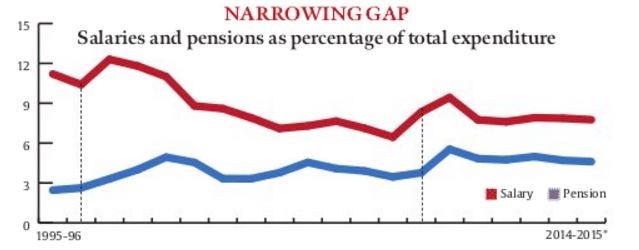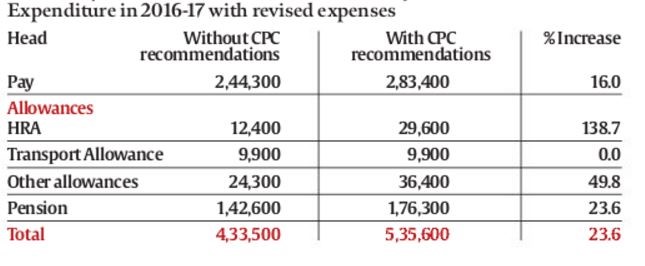Date : 30.06.2016






Seventh Pay Commission: Who’s Got a Raise?
In November 2015, the Seventh Central Pay Commission recommended changes in the pay of around 1 crore individuals — 33 lakh central government employees, 14 lakh armed forces personnel, and 52 lakh pensioners.
The central government periodically sets up a Pay Commission to evaluate and recommend revisions of salaries and pensions for its employees. In November 2015, the Seventh Central Pay Commission recommended changes in the pay of around 1 crore individuals — 33 lakh central government employees, 14 lakh armed forces personnel, and 52 lakh pensioners. On Wednesday evening, Finance Minister Arun Jaitley told a press conference that the government had decided to “by and large” accept the recommendations.
> Central government employs 8.5% of India’s organised workforce. The Armed Forces are the country’s biggest employer.
The central government’s share in organised sector employment has gradually fallen over the past 15 years. In 1994, 12.4% of the organised workforce were central government employees; in 2012 they were only 8.5%.
Sources: Economic Survey of India, PRS; *Provisional data

In 2014, the central government employed 47 lakh — nearly 30% (14 lakh) of whom were armed forces personnel. The Railways followed close behind, with a 28% share in employees. Between 2006 and 2014, all ministries except Home saw a decrease in employees. The number of MHA employees (including the paramilitary forces) went up by 32% during this period.
Sources: Report of the Seventh Central Pay Commission, PRS; *Includes Central Armed Police Forces; **Data for Defence (military) not available for 2006
> 89% of all employees belong to Group C. 1 in 5 central government positions is vacant.
88.7% belong to Group C (those providing assistance), followed by Group B (8.5%; middle management) and Group A (2.8%; those who hold the higher administrative positions).
Sources: Report of the Seventh Central Pay Commission, PRS
> Defence personnel constitute largest share among pensioners, followed by the Railways

7.47 lakh positions are vacant in the central government, excluding in the Armed Forces — a vacancy of 18.5%. The Revenue Department is the emptiest, with vacancies adding up to 45% of sanctioned strength. In terms of numbers, the Railways has the most unfilled positions — 2.35 lakh.
Sources: Report of the Seventh Central Pay Commission, PRS; *Includes Central Armed Police Forces
Defence personnel constitute largest share among pensioners, followed by the Railways

As of January 2014, central government pensioners numbered 51.96 lakh. Defence personnel constituted 46.5% of the total, followed by Railways (26.5%). The large share of defence personnel may be due to early retirement of these personnel as compared to other government employees.
Sources: Report of the Seventh Central Pay Commission, PRS

> Nearly 8% of total spending is on salaries; well above half of that is on pensions

In 2014-15, the central government is expected to spend 7.8% of its total expenditure on salaries, and 4.6% on pensions. Expenditure on salaries and pensions spiked after the 5th and 6th Pay Commission recommendations were implemented in 1997-98 and 2008-09 respectively.
Sources: Indian Public Finance Statistics, Ministry of Finance, PRS; Dotted lines indicate year of submission of Pay Commission Report; *2013-14 (Revised Estimates), 2014-15 (Budget Estimates)
Overall expenditure is estimated to increase by 23.6%

> Government expenditure on pay, allowances and pension (PAP) is expected to increase by 23.6%
> Expenditure on pay is expected to increase by 16%, on allowances by 63%, and on pension by 24%
> Additional expenditure is expected to increase the ratio of PAP as percent of GDP from 2.8% in 2015-16 to 3.4% in 2016-17
> Expenditure on pay is expected to increase by 16%, on allowances by 63%, and on pension by 24%
> Additional expenditure is expected to increase the ratio of PAP as percent of GDP from 2.8% in 2015-16 to 3.4% in 2016-17
Sources: Report of the Seventh Central Pay Commission, PRS; Figures in Rupees crore
DATA COURTESY: PRS LEGISLATIVE RESEARCH All calculations based on recommendations of the Seventh Pay Commission








No comments:
Post a Comment